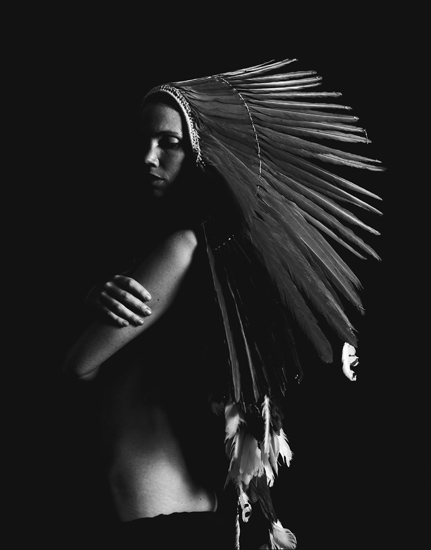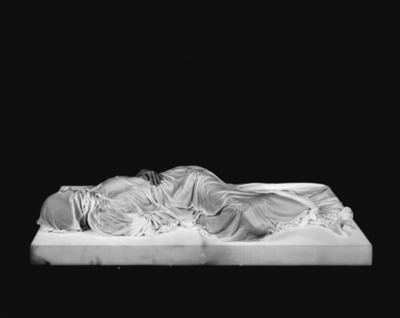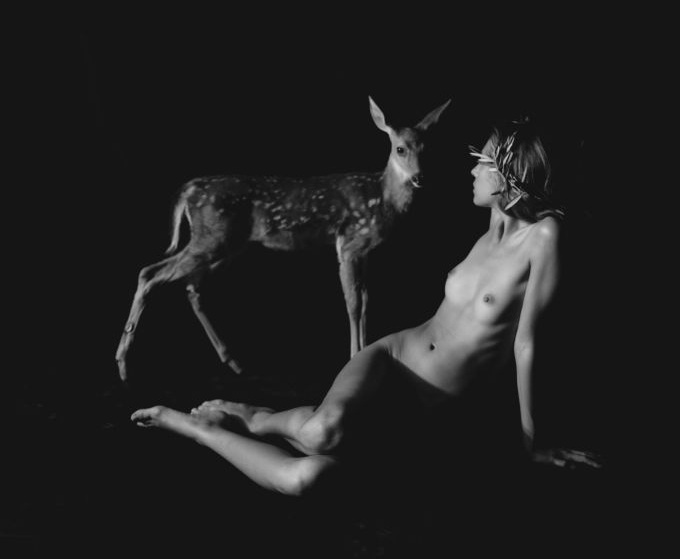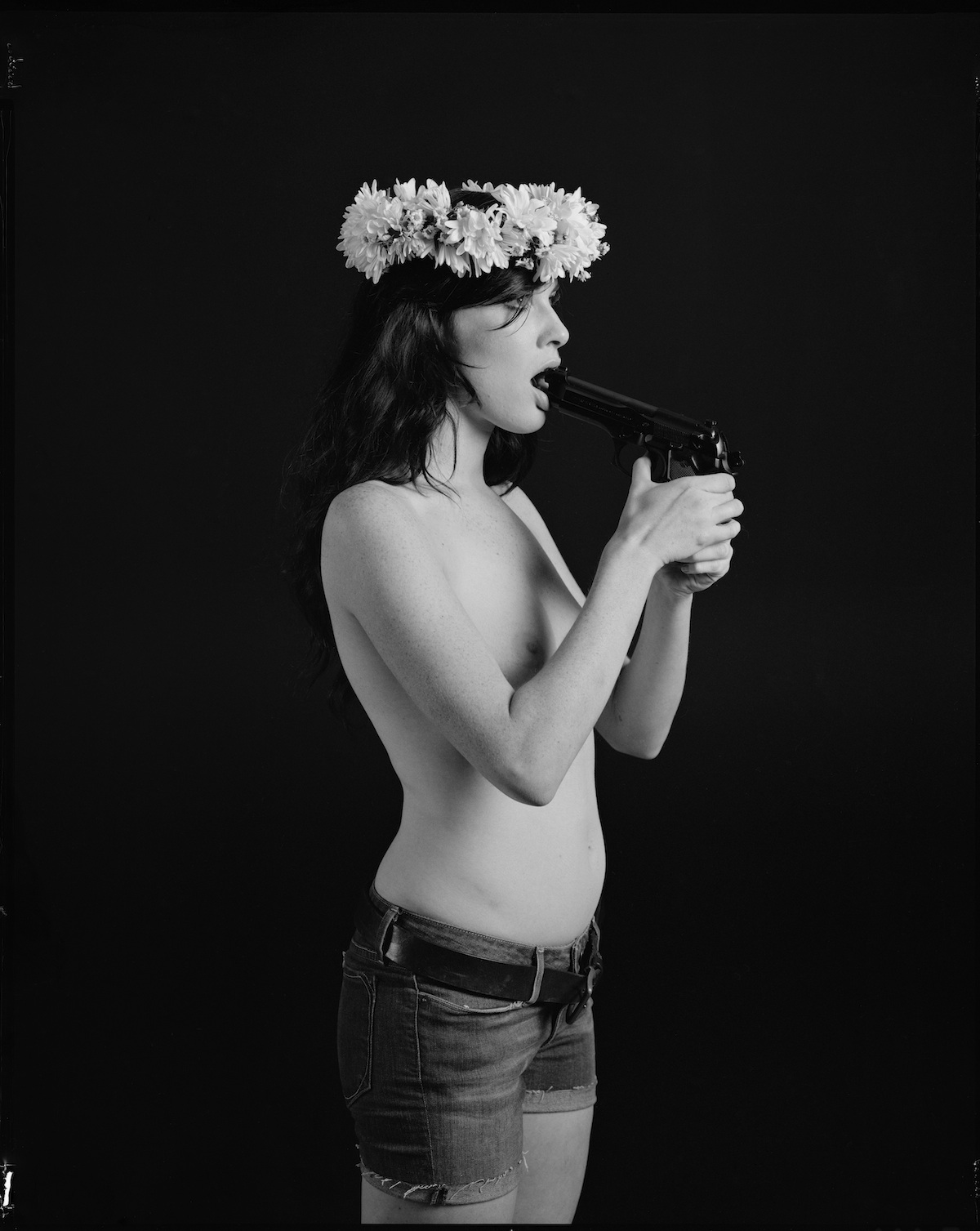
Maxwell Snow, "Untitled," 2011. Photograph. Courtesy Maxwell Snow.
In Black Magic at Serieuze Zaken Studioos in Amsterdam, New York-based photographer Max Snow continues to pursue themes that have become the central preoccupations of his photography: beauty, fantasy, mortality. Expanding on the stark frontality and straightforward style that characterized the penetrating images of his earlier KKK series, Snow turns his attention in this latest suite of photographs to the time-honored subject of the nude, exploring the power and the poignancy of the human body in portraits of such hallucinatory clarity that his subjects seem conjured from the deep recesses of his own imagination as much as they do from popular culture or classical tradition.
Photographing nude models in an even studio lighting and against a featureless black backdrop, Snow focuses the viewer’s gaze firmly on his subjects by abstracting them from any precise time or place and capturing them in symbolically charged and often dramatic poses. In many of these images, Snow juxtaposes his nudes with live animals—a wolf, a bear, and birds of prey: real equivalents of powerful symbols of spirituality and revelation but also emblems of nature’s unflinching power and ferocity. In others, his graceful nudes are accompanied by objects—a crystal orb, a spear, an animal’s pelvic bone or antler—that seem freighted with symbolic significance yet which defy easy interpretation. Imbued with apparent meaning—here death and dying, there perhaps spiritual regeneration or potency—Snow’s photographic fantasy world of animals, objects and seductive bodies becomes less an arrangement of iconographic symbols than a labyrinth of enigmatic signifiers.

Maxwell Snow, "Untitled (Shroud)," 2011. Photograph. Courtesy Maxwell Snow.
This ambiguity is particularly evident in Untitled (Shroud), in which Snow has photographed a female nude lying languidly in repose on a bed, shrouded from head to toe in a wet sheet. The contours of the model’s naked body are revealed through the transparency of the cloth clinging to it, a feature that calls to mind the wet-drapery style of marble statuary from classical antiquity. But if this and other images in Black Magic invoke the idealized nudes of the classical past, it is for Snow a reference inflected through such 19th-century symbolists as Arnold Böcklin, whose enigmatic paintings of mythological narratives and melancholic figures can be seen as forerunners to the atmosphere of mystery and anxiety that pervades his own photographs. Indeed, in a manner befitting the enigmatic and uncanny qualities of Böcklin’s imagery, the recumbent nude in Snow’s Unititled (Shroud) evokes the idealizations of the classical past in a way that unsettles that tradition from within. For as the viewer’s eye gazes over this alluring depiction of the female nude, the sculptural illusion is disturbed—and the seductive fantasy dispelled—by the model’s exposed left hand, which is draped across her midsection and remains uncovered by the wet, gauzy material.
This visible hand transmutes the beautiful body shrouded in white from the abstractions of antiquity into the present tense, the manifest flesh a reminder of the living, mortal body laying beneath the veil and a point of resistance to the idealizing pull of the photograph’s classical motif. Maintaining a tension between the classical schema of the nude and the funerary, even macabre overtones of the vulnerable and inert body imaged before us, Snow’s exquisite composition condenses a number of contradictory sensations—attraction and anxiety, fantasy and repulsion, artifice and imminence—which subtly disrupt any pretensions toward the ideal or the monumental.
As with many of Snow’s photographs in Black Magic, viewing Untitled (Shroud) ultimately becomes an encounter with the nature of our most basic desires: sexual, aesthetic, and supernal. As much meditations on death as they are on timeless beauty, the intensity of Snow’s images revolves around the tension between his lean, matter-of-fact presentation of his subjects and the unmistakable symbolic dimension of his subject matter. Mining the intersection between the metaphysical and darker allegorical themes of mortality and decay, the object of Snow’s photographic gaze in each of these images is not the idealized nude before his lens, but rather the delicate balance between transcendent beauty and corporeal truths, between the eternal and the fleeting.
The ultimate rendering of these concerns is Snow’s portrait of his own father, Chris. Stylistically similar to the other images, Chris is shown completely nude against a darkened backdrop, with a live wolf at his feet. He stands in a slight contrapposto pose, his shoulders hunched and his face partly obscured by his long hair. His body, with its distinct paunch and mangled right hand, functions as a stark testament to the deleterious effects of time and incident and the faltering of the physical body. Stripped of artifice and irony, Chris’s vulnerable, naked presence invests the photograph with a startling honesty. Potent symbols of death and regeneration are sprawled at his feet: a human skull, an unidentifiable animal’s pelvic bone and antler and the wolf itself. Snow’s photograph captures his father as he extends his left hand down towards the wolf, whose snout is raised to meet it, its muzzle wrinkled and teeth bared in an ambiguous sign of either aggressiveness or perhaps simply of curiosity and discovery. Accentuated by the inconclusive meanings of the objects around him, Chris’s primal encounter with the wolf—the outcome of which remains decidedly indeterminate—becomes a surrogate for the uncertainties in human existence. Distilling his subject down to the spiritual possibilities in and harsh realities of the human condition, Snow’s poignant portrait of his own father becomes an elegiac meditation on life and death.

Maxwell Snow, "Untitled," 2011. Photograph. Courtesy Maxwell Snow.
Indeed, with their different and competing allusions, their symbolic fragments and dreamlike spatial constructions, all of Snow’s photographs on exhibit in Black Magic might be said to illuminate beauty, but it is a beauty invested with melancholy and portent. Creating a tension that is never fully resolved, Snow instead elevates this irresolution to the status of high art. Exploring themes at once deeply personal and universal, Snow’s powerful photographic tableaux remain poised precariously between epiphany and elegy, his images presenting an auratic ideal intertwined with and punctuated by their own dissolution.

Maxwell Snow, "Untitled," 2011. Photograph. Courtesy Maxwell Snow.
Max Snow: Black Magic is on view at Serieze Zaken Studioos in Amsterdam, The Netherlands, until June 30, 2011.



